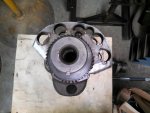Been Thinking. Always a dangerous thing when I start thinking.
- How much torque does it take to make the cam gear slip on the cam shaft?
- We know the cam gear slips on the cam shaft because of all the damage to the alignment pins on stock cams. Even at stock power levels.
- The cam gears are helical
- Helical gears generate thrust on the shafts that drive them.
- How much thrust?
- Can we figure out how much axial thrust is being applied to the Crank?
- Knowing how much force it takes to move the cam gear, what is causing all that force. Valve train resistance or rattle from the crank.
- Lastly, are these additional forces enough to fatigue the crank?


